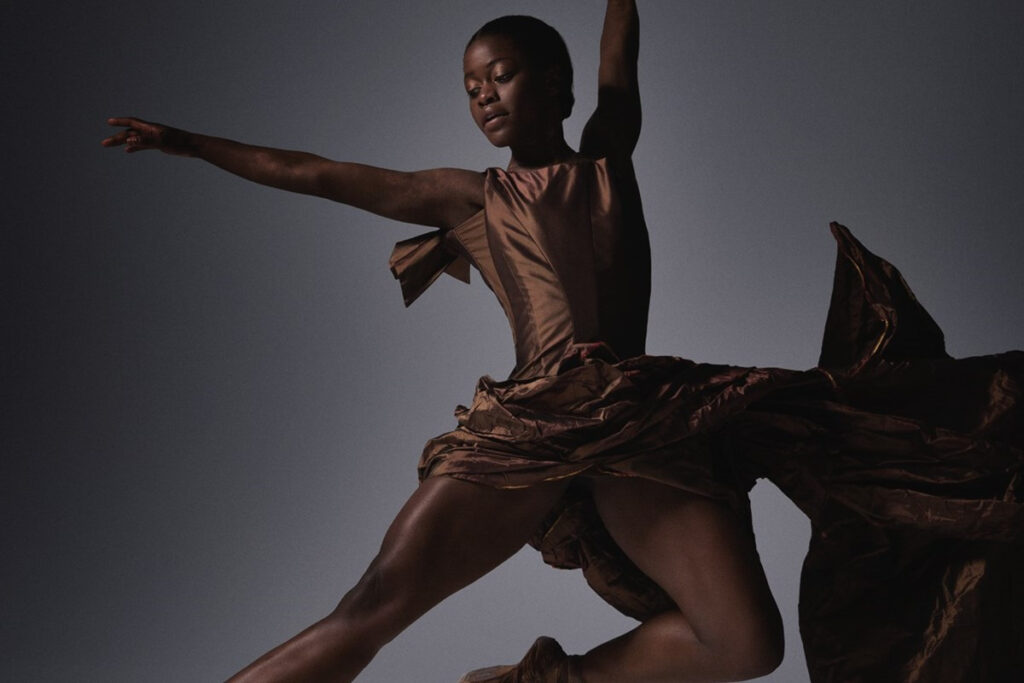The Loss of a Brilliant Star
The dance world lost one of its brightest stars when Michaela Mabinty DePrince passed away at the age of 29. Her death left the ballet community and her global audience in mourning, as her extraordinary journey from war-torn Sierra Leone to the pinnacle of ballet success was cut short. Despite her untimely passing, Michaela’s impact on both the ballet stage and the lives of many, particularly children affected by war, will continue to shine.
This detailed account delves into Michaela DePrince’s life, exploring how she overcame insurmountable obstacles to rise to prominence in an art form that has historically been unwelcoming to people of color. Her story reflects themes of resilience, perseverance, and hope. It is also a testament to the power of dance as a transformative tool, both for individuals and communities.
Early Life: Born Amid Conflict
Michaela Mabinty DePrince was born as Mabinty Bangura in 1995 in the West African country of Sierra Leone, a nation in the midst of a brutal 11-year civil war. This period was marked by widespread violence, displacement, and human rights abuses, with civilians often caught in the crossfire between rebel factions and government forces. By the age of three, young Mabinty had already experienced unimaginable loss: both of her parents were killed in the conflict. Her father was murdered by rebels, and her mother, weakened by starvation, passed away shortly thereafter. This left Mabinty as an orphan, facing an uncertain and harsh future.
She was placed in an orphanage where life proved to be a daily struggle for survival. At the orphanage, Michaela endured mistreatment, neglect, and malnourishment, exacerbated by her skin condition, vitiligo, which caused patches of depigmentation. This made her an object of ridicule and discrimination even among the other orphans. Children at the orphanage were ranked by the caregivers, with the more “desirable” children receiving better care. Mabinty was assigned the number 27, the lowest rank, which meant she received the least amount of food, attention, and clothing. In a 2012 interview with the Associated Press, Michaela reflected on the dehumanizing experience: “We were ranked as numbers, and number 27 was the least favorite, and that was my number. I got the least amount of food, the least amount of clothes.”
Despite the harsh environment, Michaela found solace in a tattered magazine she discovered in the orphanage. The magazine featured a picture of a ballerina, a woman of grace and beauty, representing a world far removed from the horrors of civil war. That image sparked a dream in Michaela—a dream that seemed almost impossible at the time. Yet it was one she would cling to with determination.
The Life-Changing Adoption: A New Chapter in America

In 1999, fate took a kinder turn when Michaela and her best friend, Mia, were adopted by an American couple, Elaine and Charles DePrince. The DePrince family had already adopted two other girls from the same orphanage, creating a new life filled with love, support, and opportunities. Elaine DePrince had initially traveled to Sierra Leone intending to adopt only one child, but when she saw Michaela and Mia sleeping together on a mat, bonded by their shared hardship, she knew she had to adopt both.
When the DePrince family brought Michaela to their home in Cherry Hill, New Jersey, the little girl who had grown up in an environment of scarcity and violence now had the chance to dream again. Michaela’s dream of becoming a ballerina, inspired by that magazine image, was encouraged by her new family. They quickly recognized her passion for dance, enrolling her in ballet classes despite the challenges that lay ahead.
Michaela’s enthusiasm for ballet was apparent from the moment she stepped into a dance studio. She immersed herself in the art form with a sense of purpose that belied her young age. The structure and discipline of ballet offered her both physical and emotional healing after years of trauma. However, while ballet provided her with a means of expression and escape, it was also a world that posed significant obstacles.
Confronting Racism in Ballet: Overcoming Prejudice
Ballet is a demanding and competitive art form, requiring not only technical skill but also a deep cultural understanding and conformity to aesthetic traditions. Historically, those traditions have favored dancers who are white and have a particular body type, leaving little room for diversity. For a young Black girl like Michaela, the world of ballet was fraught with prejudice.
At the age of eight, Michaela experienced her first brush with the racial barriers that would challenge her throughout her career. After being cast in the role of Marie in a local production of The Nutcracker, a teacher informed her that America was “not ready” for a Black girl in such a prominent role. Another teacher even went as far as to tell her adoptive mother that Black girls were not worth investing in when it came to ballet training.
Despite these painful experiences, Michaela refused to give up on her dream. Instead, she used the criticisms and rejections as fuel to push herself even harder. Her determination led her to pursue training at the prestigious Rock School for Dance Education in Philadelphia, one of the top ballet schools in the country. Here, Michaela’s natural talent flourished, and she began to gain recognition for her abilities.
However, she was not only battling the physical demands of ballet but also the systemic racial biases ingrained in the art form. Ballet companies and schools often had limited opportunities for dancers of color, with few roles or scholarships available to Black performers. Michaela understood that she would need to break these barriers to achieve her goals, and she was prepared to do so.
Breaking Through: A Star in the Making
In 2009, Michaela’s efforts paid off in a significant way. At the age of 14, she earned a scholarship to attend the Jacqueline Kennedy Onassis School at the American Ballet Theatre (ABT) in New York City. This prestigious institution is known for shaping the careers of some of the world’s greatest ballet dancers. The opportunity to train at ABT was a dream come true for Michaela, and it marked a major turning point in her career.
Her experience at ABT was transformative. Here, Michaela found herself surrounded by dancers of extraordinary talent, but she stood out for her unique combination of technical prowess and emotional expression. She quickly became known for her ability to convey powerful stories through movement, connecting with audiences on a deeper level. Michaela’s presence on stage was both captivating and commanding, attributes that would serve her well as she prepared for a professional career in ballet.
In 2011, Michaela’s story was featured in the award-winning documentary First Position, which followed six young dancers as they prepared for the Youth America Grand Prix (YAGP), one of the most prestigious ballet competitions in the world. The documentary highlighted Michaela’s journey from orphan to rising star in the ballet world, capturing both the beauty of her dance and the struggles she faced along the way. Her perseverance and grace under pressure resonated with audiences, earning her widespread recognition.
Following her appearance in First Position, Michaela’s career began to soar. In 2012, she performed in her first professional full ballet in South Africa, an experience that further solidified her place as a rising star. The following year, she joined the Dutch National Ballet’s junior company, where she quickly moved up the ranks to become a soloist. Her performances were noted for their precision, emotion, and the sheer joy she brought to the stage.
Beyond the Stage: Michaela’s Impact on the World
While ballet was Michaela’s primary passion, she never forgot her roots or the hardships she had endured as a child in Sierra Leone. She channeled her success into helping others, using her platform as a dancer to advocate for humanitarian causes. Michaela’s early experiences with war and displacement fueled her desire to make a difference in the lives of children who, like her, had been affected by conflict and poverty.
Michaela became an ambassador for War Child Holland, an organization that works to support children in war-torn regions around the world. Through this role, she traveled extensively, offering dance workshops and training sessions to children in countries affected by war. She believed deeply in the power of dance as a tool for healing and empowerment, and she wanted to share that gift with others.
One of Michaela’s most meaningful initiatives was her work in Sierra Leone, where she returned to provide dance classes for young girls. For Michaela, it was a full-circle moment: she had escaped the horrors of war and found a new life through ballet, and now she was offering others the same chance to dream. Her work in Sierra Leone was not just about teaching dance; it was about showing the children that they, too, had the potential to rise above their circumstances.
Her humanitarian work extended beyond Africa. Michaela was a frequent advocate for diversity and inclusion in ballet, speaking out about the need for more opportunities for dancers of color. She understood that her success as a Black ballerina was a rarity, and she wanted to pave the way for others who would follow in her footsteps. Michaela used her platform to challenge the ballet world’s traditional notions of beauty, advocating for a more inclusive and representative art form.
A Cultural Icon: Dancing into Popular Culture
Michaela’s impact extended beyond the ballet stage and into the realm of popular culture. In 2016, she was featured in Beyoncé’s groundbreaking visual album Lemonade, which celebrated Black womanhood and resilience. Michaela’s performance in the album was a powerful statement of Black excellence, and it introduced her to a broader audience beyond the world of ballet. Her appearance in Lemonade was a testament to her growing influence as both a dancer and a cultural icon.
Michaela’s story also resonated with people through her memoir, Taking Flight: From War Orphan to Star Ballerina, co-authored with her adoptive mother, Elaine DePrince. The book, which chronicled her journey from Sierra Leone to international stardom, became a bestseller and inspired countless readers around the world. In her memoir, Michaela shared not only her triumphs but also her struggles, offering a candid look at the challenges she faced as a Black ballerina in a predominantly white art form. Taking Flight was particularly popular among young readers, many of whom saw in Michaela a role model who defied the odds to achieve her dreams.
The Loss of Michaela: A Tragic End to a Remarkable Life
In September 2023, the ballet world was devastated by the news of Michaela DePrince’s untimely death at the age of 29. Her family confirmed her passing in a heartfelt social media post, expressing their deep sadness at the loss of such a bright and beloved figure. The announcement shocked Michaela’s fans and colleagues, many of whom had watched her career flourish over the years.
While the cause of her death has not been publicly disclosed, the outpouring of grief from the dance community and beyond spoke to the profound impact Michaela had made in her short life. Tributes poured in from fellow dancers, choreographers, and admirers, all of whom remembered her not only for her extraordinary talent but also for her kindness, generosity, and commitment to making the world a better place.
Her sister, Mia, who had shared so much of Michaela’s journey, reflected on their bond in the days following her death. “We created our own ballets,” Mia wrote, remembering how they had choreographed performances together in the orphanage, long before Michaela had ever set foot in a dance studio. “She was an inspiration,” Mia added, capturing the essence of the impact Michaela had on those who knew her best.
Michaela’s Legacy: A Lasting Influence
Michaela DePrince’s legacy is one of triumph over adversity, a story of resilience that will continue to inspire future generations of dancers and dreamers. Her journey from orphan to prima ballerina broke down barriers in a world that had long excluded people like her. In doing so, Michaela paved the way for greater diversity and inclusion in ballet, challenging the industry to rethink its standards and embrace a more inclusive vision of beauty.
Michaela’s influence extends beyond the realm of dance. Her humanitarian work, particularly her advocacy for children affected by war, will continue to impact lives long after her passing. Through her efforts with War Child Holland and other organizations, Michaela used her platform to bring attention to the plight of the most vulnerable, offering hope and support to those in need.
Her memoir, Taking Flight, will remain a source of inspiration for young people, particularly those who face obstacles in the pursuit of their dreams. Michaela’s story is a reminder that with determination, passion, and support, even the most improbable dreams can become reality.
Conclusion: A Life That Will Continue to Shine
Michaela DePrince’s life was a gift to the world, one that was tragically cut short but will continue to resonate for years to come. Her journey from the hardships of Sierra Leone to the world’s most prestigious ballet stages is a powerful testament to the strength of the human spirit. Through her dedication to her craft, her commitment to helping others, and her ability to inspire, Michaela left an indelible mark on the world.
As we remember Michaela DePrince, we celebrate not only her extraordinary talent but also her unshakable belief in the power of dreams. She showed us that it is possible to rise above adversity, to break down barriers, and to make a lasting difference in the lives of others. Michaela’s brilliance will continue to shine through the dancers she inspired, the lives she touched, and the legacy she left behind.
In her own words, “You can do anything if you believe in yourself.” Michaela DePrince believed, and through her belief, she gave the world a gift that will never be forgotten.





